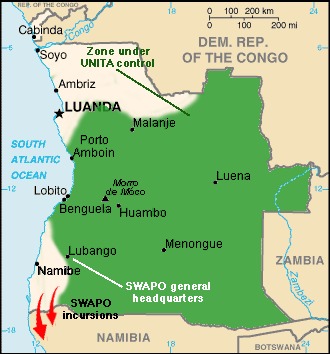Case Study: Cuban Intervention During the Angolan Civil War, 1975-91
A Land Far Away
The Cold War provided no shortage of examples of nations involving themselves via either proxy or direct intervention in the affairs of another. One would perhaps be first drawn to consider twofold the foreign interventions by the pair of usual suspects, the United States and the Soviet Union, in Vietnam and Afghanistan, respectively. But these interventions, albethey obvious, were not the only of the sort. Nor was occupational interventionism exclusive to superpowers, either. One nation that broke the dichotomy of the proxy mould and remained active in not only another nation, but another continent altogether for over a quarter-century was Cuba when they came to the aid of the People’s Movement for the Liberation of Angola (MPLA) in 1975. Together, Cuban soldiers aided the MPLA in overcoming a Chinese and United States-backed coalition of the National Union for the Total Independence of Angola (UNITA), the National Liberation Front of Angola (FNLA), and apartheid South Africa, resulting in an MPLA victory at the Battle of Cuito Cuanavale and the subsequent 1988 New York Accords that both liberated Namibia from South Africa and ended foreign intervention in the Angolan Civil War.
The Cuban prerogative for intervention in Africa rested on an ideological bed. Specifically, Cuba sought the presence of more global communist states and Cuban Prime Minister Fidel Castro, as opposed to his Soviet leadership counterparts, believed that Africa was both particularly susceptible to, and well positioned for, communism [1]. Africa also conveniently saw the departure of many colonial powers, such as Portugal in the case of Angola, leaving Cuban chances to compete in warfare much higher than, say, in Latin or Central America. Likewise, intervention in the latter would undoubtedly have provoked the ire of the United States and was thus best left for the Soviet Union instead.
That is not to say that the United States had no interest in Africa; by contrast, they were quite keen. Matters were complicated, however, when, for instance, the Angolan Civil War spilled into Namibia and thus implicated the South Africans, who were busy trying to suppress an independence movement therein. Apartheid was not popular internationally and, as a result, the United States chose not to directly intervene, much to the amenity of Cuba. In other words, the Angolan Civil War became a proxy war between South Africa (with Chinese and American support) and Cuba (with Soviet support) in Namibia. Angola effectively thus operated as a sort of “mini-Vietnam” for South Africa. You could almost call Angola the “Cuba” of Africa.
Given the aforementioned, Angola was ultimately not the first foreign intervention in Africa by Cuba, but it was perhaps their greatest endeavor. When Cuban soldiers first arrived at Algeria in 1963 both in support of and at the request of their socialist ally, President Ahmed Ben Bella, the Cuban government did not entirely understand the local nuances and complicated sociopolitical situation at play across Africa amidst the contemporary changes championed by decolonization [2]. The following decade-and-a-half served as a learning process for the Cubans as they further refined, detailed, and characterized their methods of foreign aid to better fit the existing systems of the people whom the Cubans sought to aid [3].
The decisions which led to Cuba taking such an active role in domestic African struggles of communist liberation are diverse and intricate in nature. The case study of Angola, which we will now explore in earnest, is an example of Westadian methods in action. The Cubans were ultiamtely acting on behalf of a strong idealistic belief in their own political ideology with respect to particular experiences and historical trends within Cuba, and not to serve the bidding of a larger, hegemonic Soviet state.
Cuba In Africa: A Timeline
Below is a short timeline to expand on the various experiences of Cuba across Africa. Readers are encouraged to consider how each event differs from one another, and how neglecting these differences may, in turn, disrupt interpretation.
-------------------------------------------------------------
[1] See Piero Gleijeses, Conflicting Missions: Havana, Washington, and Africa, 1959-1976 (Chapel Hill: University of North Carolina Press, 2002), for elaboration. Gleijeses, as will be explored shortly, provides a succint synopsis of Cuban motivations in Africa. See also the work of Jorge Domínguez, including Cuba: Order and Revolution (Cambridge: Belknap Press, 1978); and To Make a World Safe for Revolution: Cuba's Foreign Policy (Cambridge: Harvard University Press, 1989). Further, see Edward George, The Cuban Intervention in Angola, 1965–1991 (New York: Frank Cass, 2005); R.L. Harris, “Cuban Internationalism, Che Guevara, and the Survival of Cuba’s Socialist Regime,” Latin American Perspectives 36, no. 166 (2009): 27–42; Hal Klepak, Cuba's Military 1990–2005: Revolutionary Soldiers During Counter-Revolutionary Times (Basingstoke: Palgrave-Macmillan, 2006); and Louis A. Pérez, Cuba: Between Reform and Revolution (New York: Oxford University Press, 1988).
[2] Gleijeses initially presents this idea in Conflicting Missions, and then later furthers it in Visions of Freedom: Havana, Washington, Pretoria and the Struggle for Southern Africa, 1976-1991 (Chapel Hill: University of North Carolina Press, 2013).
[3] Ibid. See also Domínguez, To Make a World Safe for Revolution; and Klepak, Cuba's Military 1990–2005.


